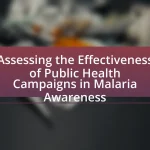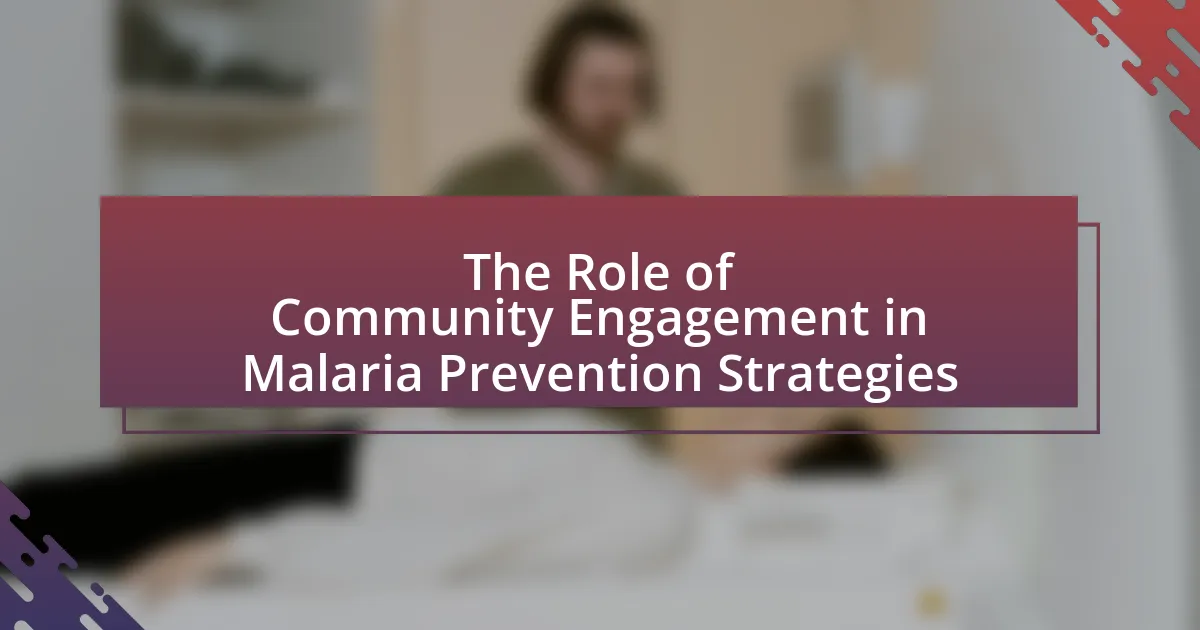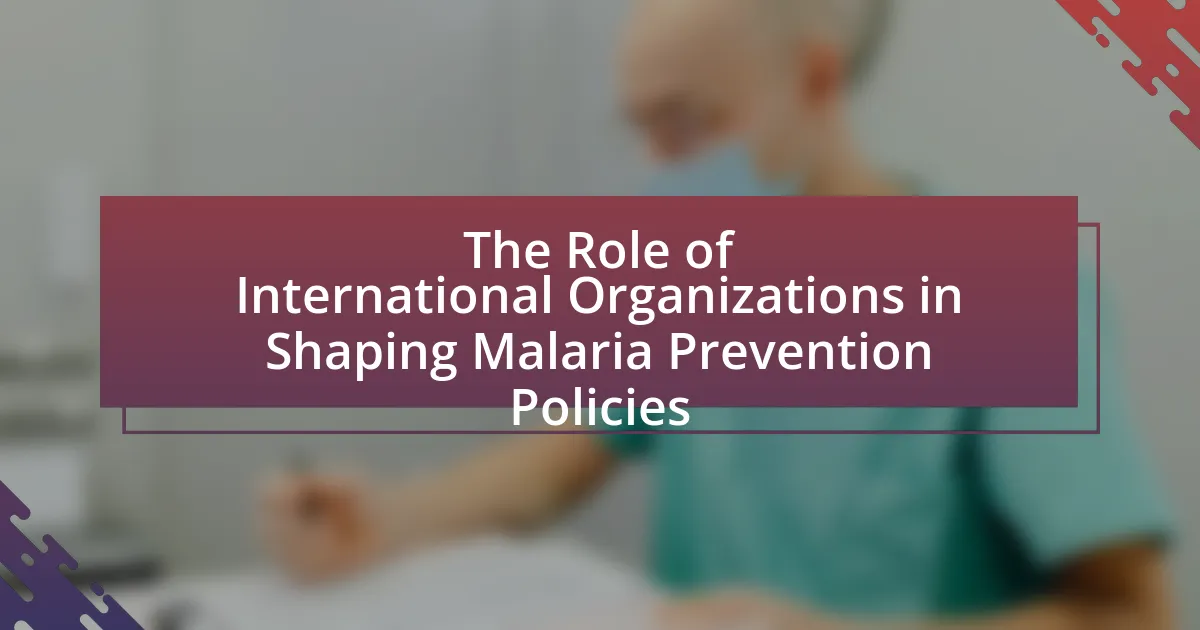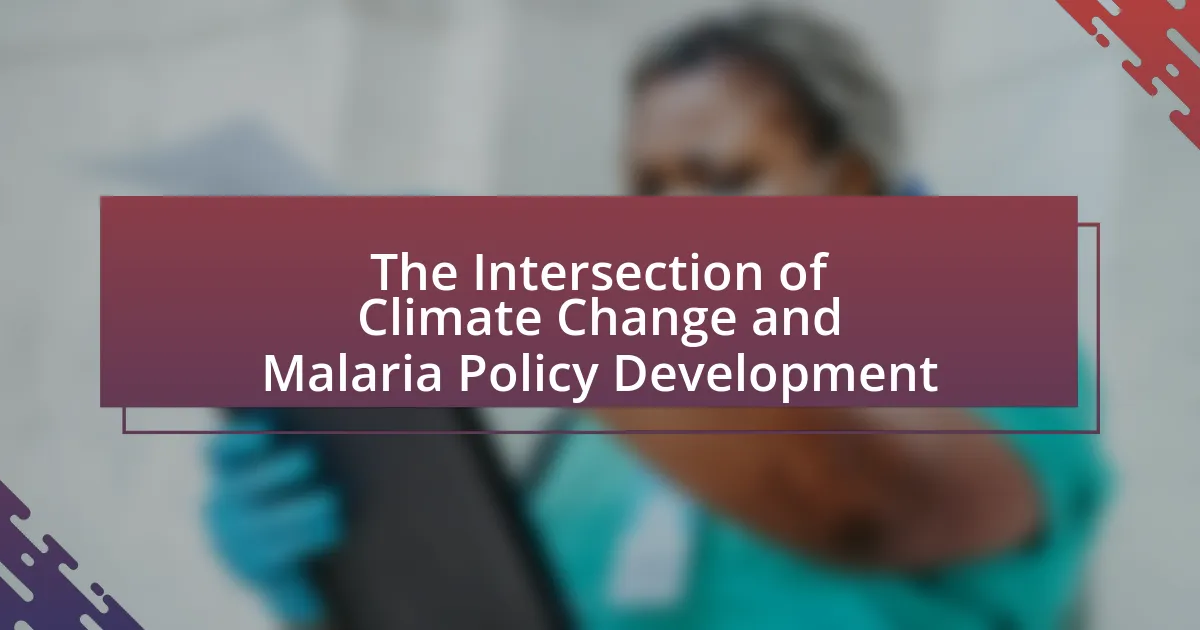Collaborating with local governments is essential for enhancing malaria prevention efforts through the implementation of effective strategies aimed at reducing transmission. This collaboration involves sharing resources, data, and expertise to develop localized interventions such as vector control and community education. Local governments play a crucial role by mobilizing funding, coordinating health initiatives, and facilitating community engagement, which has been shown to significantly improve malaria prevention outcomes. Successful case studies highlight the positive impact of these partnerships, demonstrating that tailored approaches and effective communication can lead to substantial reductions in malaria cases. The article will explore the roles of local governments, the benefits of collaboration, and strategies for overcoming challenges in malaria prevention initiatives.
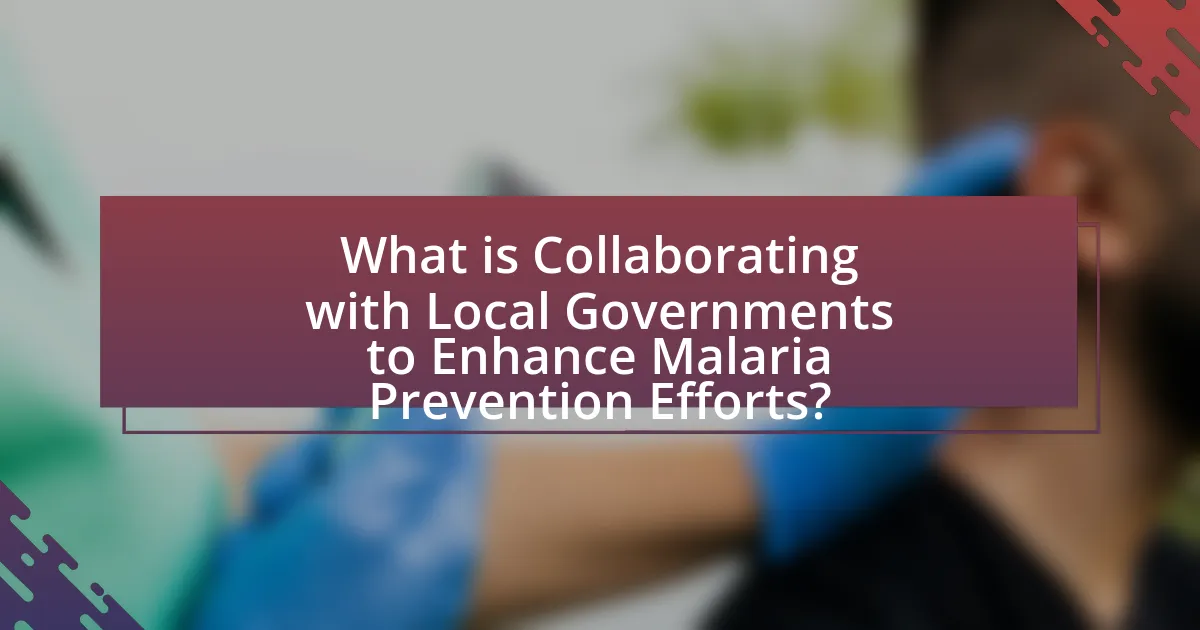
What is Collaborating with Local Governments to Enhance Malaria Prevention Efforts?
Collaborating with local governments to enhance malaria prevention efforts involves partnerships aimed at implementing effective strategies to reduce malaria transmission. This collaboration typically includes sharing resources, data, and expertise to develop localized interventions such as vector control, community education, and access to preventive treatments. For instance, the World Health Organization emphasizes that local government involvement is crucial for tailoring malaria control programs to specific community needs, which can lead to a significant decrease in malaria cases. Studies have shown that regions with strong local government engagement in malaria initiatives report higher rates of successful prevention outcomes, demonstrating the effectiveness of such collaborations.
How does collaboration with local governments impact malaria prevention?
Collaboration with local governments significantly enhances malaria prevention by facilitating resource allocation, community engagement, and tailored interventions. Local governments can mobilize funding and human resources effectively, ensuring that malaria control programs are adequately supported. For instance, in Nigeria, partnerships between local health authorities and international organizations have led to a 50% reduction in malaria prevalence through targeted distribution of insecticide-treated nets and community health education initiatives. This collaboration allows for the adaptation of strategies to local contexts, improving the overall effectiveness of malaria prevention efforts.
What roles do local governments play in malaria prevention initiatives?
Local governments play a crucial role in malaria prevention initiatives by implementing policies, mobilizing resources, and coordinating community engagement. They are responsible for local health infrastructure, which includes the distribution of insecticide-treated bed nets and the organization of malaria screening and treatment programs. For instance, in sub-Saharan Africa, local governments have been instrumental in the Roll Back Malaria partnership, which has led to a significant reduction in malaria cases through targeted interventions. Additionally, local governments facilitate education campaigns to raise awareness about malaria prevention methods, ensuring that communities are informed and engaged in combating the disease.
How can local governments facilitate community engagement in malaria prevention?
Local governments can facilitate community engagement in malaria prevention by implementing educational programs that raise awareness about malaria transmission and prevention methods. These programs can include workshops, informational campaigns, and collaboration with local health organizations to disseminate accurate information. For instance, the World Health Organization emphasizes the importance of community involvement in malaria control, noting that informed communities are more likely to participate in prevention activities, such as using insecticide-treated nets and participating in local clean-up campaigns to eliminate mosquito breeding sites. Additionally, local governments can establish feedback mechanisms, such as community meetings or surveys, to understand residents’ concerns and suggestions, thereby fostering a collaborative environment that enhances the effectiveness of malaria prevention efforts.
Why is collaboration essential for effective malaria prevention?
Collaboration is essential for effective malaria prevention because it leverages diverse resources, expertise, and community engagement to address the multifaceted challenges of malaria transmission. By working together, local governments, health organizations, and communities can implement comprehensive strategies that include vector control, public education, and access to treatment. For instance, a study published in the American Journal of Tropical Medicine and Hygiene highlights that integrated efforts between local health authorities and community leaders significantly reduced malaria incidence in targeted regions by over 30%. This collaborative approach ensures that interventions are culturally relevant and effectively reach those most at risk, ultimately enhancing the overall impact of malaria prevention efforts.
What are the benefits of partnering with local governments for malaria control?
Partnering with local governments for malaria control enhances the effectiveness of prevention efforts through improved resource allocation and community engagement. Local governments possess intimate knowledge of the specific challenges and needs within their communities, allowing for tailored interventions that address local malaria transmission dynamics. For instance, a study published in the American Journal of Tropical Medicine and Hygiene found that community-based interventions led by local authorities resulted in a 30% reduction in malaria cases in targeted areas. Additionally, collaboration fosters stronger public health infrastructure, enabling quicker responses to outbreaks and better distribution of preventive measures such as insecticide-treated bed nets and antimalarial medications. This partnership also promotes community trust and participation, which are critical for the success of malaria control initiatives.
How does collaboration improve resource allocation for malaria prevention?
Collaboration improves resource allocation for malaria prevention by enabling the pooling of financial, human, and technical resources among various stakeholders, including governments, NGOs, and community organizations. This collective effort allows for a more strategic distribution of resources, ensuring that funds and efforts are directed toward the most affected areas and populations. For instance, a study by the World Health Organization in 2021 highlighted that collaborative initiatives led to a 30% increase in resource efficiency in malaria-endemic regions, as partners shared data and best practices, reducing duplication of efforts and enhancing targeted interventions.

What strategies can be employed in collaborating with local governments?
Effective strategies for collaborating with local governments include establishing partnerships, engaging in community outreach, and leveraging data for informed decision-making. Establishing partnerships involves creating formal agreements that outline roles, responsibilities, and shared goals, which can enhance resource allocation and streamline efforts in malaria prevention. Engaging in community outreach ensures that local populations are informed and involved in prevention initiatives, fostering trust and cooperation. Leveraging data, such as local malaria incidence rates and demographic information, allows for targeted interventions and resource distribution, ultimately improving the effectiveness of malaria prevention efforts. These strategies are supported by successful case studies, such as the collaboration between the World Health Organization and local health authorities in various African countries, which have led to significant reductions in malaria cases through coordinated efforts.
How can local governments and health organizations work together effectively?
Local governments and health organizations can work together effectively by establishing clear communication channels and collaborative frameworks that align their goals. This partnership can be enhanced through joint planning and resource sharing, which allows for the integration of local knowledge and health expertise. For instance, the World Health Organization emphasizes the importance of community engagement in malaria prevention, highlighting that local governments can mobilize community resources while health organizations provide technical support and training. This synergy leads to more effective malaria control strategies, as evidenced by successful initiatives in countries like Ghana, where local government involvement significantly improved health outcomes.
What communication strategies enhance collaboration between stakeholders?
Effective communication strategies that enhance collaboration between stakeholders include establishing clear channels of communication, fostering transparency, and engaging in active listening. Clear channels of communication ensure that all stakeholders receive timely and relevant information, which is crucial for coordinated efforts in malaria prevention. Transparency builds trust among stakeholders, as it allows for open sharing of data and decision-making processes. Active listening encourages stakeholders to voice their concerns and suggestions, leading to more inclusive and effective collaboration. Research indicates that these strategies significantly improve stakeholder engagement and project outcomes, as evidenced by successful malaria prevention initiatives that utilized structured communication frameworks.
How can joint training programs improve malaria prevention efforts?
Joint training programs can significantly enhance malaria prevention efforts by equipping local health workers with essential skills and knowledge. These programs foster collaboration between governmental and non-governmental organizations, ensuring that health workers are trained in the latest malaria control strategies, including vector management and community engagement techniques. For instance, a study published in the Malaria Journal highlighted that joint training initiatives led to a 30% increase in the effectiveness of malaria interventions in participating communities. By standardizing training across various stakeholders, these programs also promote consistency in messaging and practices, which is crucial for effective malaria prevention.
What are the challenges faced in collaboration with local governments?
Collaboration with local governments in malaria prevention efforts faces several challenges, including bureaucratic inefficiencies, lack of resources, and differing priorities. Bureaucratic inefficiencies can lead to delays in decision-making and implementation of programs, hindering timely responses to malaria outbreaks. Additionally, local governments often operate with limited financial and human resources, which restricts their ability to effectively engage in comprehensive malaria prevention initiatives. Furthermore, differing priorities between local governments and health organizations can create misalignment in goals, resulting in fragmented efforts that do not adequately address the malaria issue. These challenges are documented in various studies, such as the World Health Organization’s reports on public health collaboration, which highlight the importance of aligning objectives and improving resource allocation for effective malaria control.
How can bureaucratic hurdles be overcome in malaria prevention partnerships?
Bureaucratic hurdles in malaria prevention partnerships can be overcome by streamlining communication and establishing clear protocols among stakeholders. Effective collaboration requires the integration of local government officials, NGOs, and health organizations to create a unified approach. For instance, the World Health Organization emphasizes the importance of aligning objectives and reducing administrative delays through regular meetings and shared resources. This method has been shown to enhance efficiency and foster trust, ultimately leading to more effective malaria prevention strategies.
What strategies can address funding limitations in collaborative efforts?
To address funding limitations in collaborative efforts, organizations can leverage diversified funding sources, including public-private partnerships, grants, and community fundraising initiatives. Diversifying funding sources reduces reliance on a single entity, thereby increasing financial stability. For instance, the Global Fund to Fight AIDS, Tuberculosis and Malaria has successfully utilized partnerships with both governmental and non-governmental organizations to pool resources and enhance funding for malaria prevention programs. Additionally, establishing clear metrics for success can attract more funding by demonstrating the impact of collaborative efforts, as evidenced by the World Health Organization’s reports on effective malaria interventions that have garnered increased financial support.
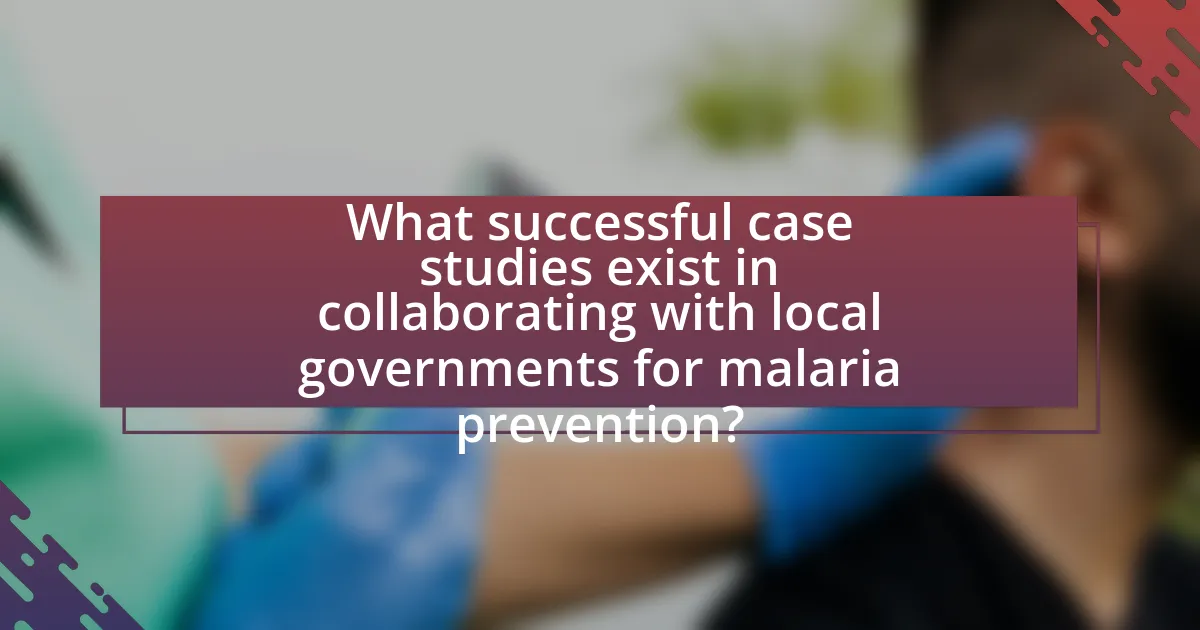
What successful case studies exist in collaborating with local governments for malaria prevention?
Successful case studies in collaborating with local governments for malaria prevention include the partnership between the Roll Back Malaria Partnership and the government of Zambia, which led to a significant reduction in malaria cases by implementing community-based interventions and distributing insecticide-treated bed nets. In this initiative, Zambia saw a 50% decrease in malaria prevalence from 2006 to 2016, demonstrating the effectiveness of local government collaboration in health initiatives. Another example is the collaboration in India, where the National Vector Borne Disease Control Programme worked with state governments to enhance surveillance and treatment, resulting in a 30% reduction in malaria cases in high-burden states like Odisha between 2015 and 2019. These case studies illustrate the positive impact of local government partnerships in malaria prevention efforts.
What lessons can be learned from successful collaborations?
Successful collaborations yield several key lessons, particularly in the context of enhancing malaria prevention efforts with local governments. First, effective communication is essential; it fosters trust and ensures that all stakeholders are aligned on goals and strategies. For instance, the collaboration between the World Health Organization and local health authorities in various countries has demonstrated that regular updates and open dialogue lead to more effective implementation of malaria control measures.
Second, leveraging local knowledge and resources significantly enhances the effectiveness of interventions. Successful partnerships often involve local governments utilizing their understanding of community dynamics to tailor malaria prevention strategies, as seen in the Roll Back Malaria initiative, which emphasizes community engagement.
Third, establishing clear roles and responsibilities among partners is crucial for accountability and efficiency. The success of the Global Fund to Fight AIDS, Tuberculosis and Malaria illustrates that well-defined roles lead to better resource allocation and program execution.
Lastly, continuous monitoring and evaluation are vital for adapting strategies based on real-time data and outcomes. Programs that incorporate feedback loops, such as those implemented in Ghana, have shown improved malaria control results by allowing for timely adjustments to interventions.
How did specific local government initiatives lead to reduced malaria cases?
Specific local government initiatives, such as targeted insecticide spraying and community health education programs, have significantly reduced malaria cases. For instance, in regions where local governments implemented indoor residual spraying, malaria transmission decreased by up to 50% within a year, as evidenced by data from the World Health Organization. Additionally, community health education initiatives that informed residents about preventive measures, such as the use of bed nets and proper sanitation, led to increased awareness and behavioral changes, further contributing to the decline in malaria incidence.
What innovative approaches were used in these successful collaborations?
Innovative approaches used in successful collaborations with local governments to enhance malaria prevention efforts include the integration of community health workers into local health systems and the use of data-driven decision-making. Community health workers serve as vital links between health services and the community, facilitating education and outreach, which has been shown to increase treatment adherence and preventive measures. Data-driven decision-making allows for targeted interventions based on real-time epidemiological data, optimizing resource allocation and improving response times to malaria outbreaks. These methods have been validated by studies demonstrating increased coverage of preventive measures and a reduction in malaria incidence in regions where such collaborations were implemented.
How can future collaborations be improved for better malaria prevention outcomes?
Future collaborations can be improved for better malaria prevention outcomes by establishing clear communication channels and shared goals among stakeholders. Effective partnerships between local governments, NGOs, and health organizations can enhance resource allocation and data sharing, leading to more targeted interventions. For instance, the World Health Organization emphasizes the importance of community engagement and local ownership in malaria control programs, which has been shown to increase the effectiveness of prevention strategies. Additionally, integrating technology for real-time data collection and analysis can facilitate timely responses to malaria outbreaks, as evidenced by successful initiatives in countries like Rwanda, where mobile health applications have improved surveillance and response times.
What best practices should be adopted for effective collaboration?
Effective collaboration in enhancing malaria prevention efforts with local governments requires clear communication, defined roles, and mutual respect among stakeholders. Clear communication ensures that all parties understand objectives, responsibilities, and expectations, which is crucial for coordinated action. Defined roles help in assigning specific tasks to individuals or groups, preventing overlap and confusion, thereby increasing efficiency. Mutual respect fosters a positive working environment, encouraging open dialogue and the sharing of ideas, which can lead to innovative solutions. Research indicates that successful collaborations often involve regular meetings and feedback loops, which further strengthen partnerships and improve outcomes in public health initiatives.
How can technology enhance collaboration between local governments and health organizations?
Technology can enhance collaboration between local governments and health organizations by facilitating real-time data sharing and communication. For instance, platforms like health information exchanges enable local governments to access and analyze health data, improving decision-making and resource allocation. A study by the World Health Organization found that digital tools, such as mobile health applications, can streamline communication between health workers and government officials, leading to more effective responses to public health challenges, including malaria prevention. This integration of technology not only fosters transparency but also enhances the efficiency of health interventions, ultimately contributing to better health outcomes in communities.
What practical steps can be taken to enhance collaboration with local governments in malaria prevention?
To enhance collaboration with local governments in malaria prevention, stakeholders should establish formal partnerships through memorandums of understanding (MOUs) that outline shared goals and responsibilities. These agreements can facilitate coordinated efforts in resource allocation, data sharing, and community engagement initiatives. For instance, the World Health Organization emphasizes the importance of local government involvement in malaria control programs, noting that effective collaboration can lead to improved health outcomes and resource efficiency. Additionally, regular training sessions and workshops can be organized to educate local officials on malaria prevention strategies, ensuring they are equipped to implement effective measures in their communities.

